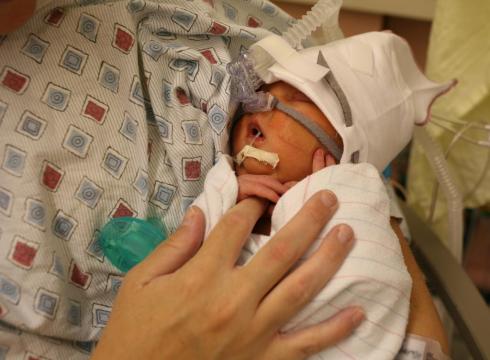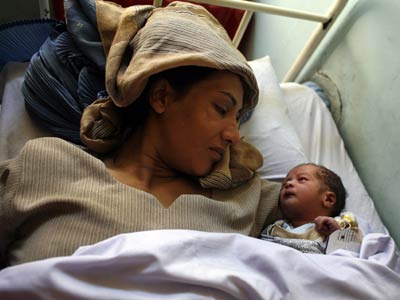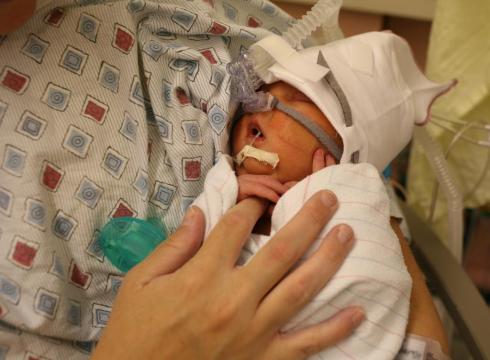
Source: Rainbow Babies and Children’s Hospital
When you think of newborns who are in a neonatal intensive care unit, you assume that the baby is receiving the best of evidence-based care. There has been a great deal of research on medical interventions for these distressed newborns, but not as much nursing research on some of the important routine care issues. And this situation could worsen, depending upon the upcoming budget negotiations between President Obama and Congress. Consider the example of how to feed distressed, very ill neonates.
Gail McCain, PhD, RN, FAAN, Dean of the Hunter-Bellevue School of Nursing, has been studying the feeding of neonates for over two decades. Her work has been instrumental in our understanding of the cues that distressed neonates demonstrate to show they’re hungry. These cues are seldom the same as “term infants” (fully developed and delivered at a minimum of 40 weeks of gestation), so nurses, physicians, and even parents may not recognize that the neonate is hungry and ready to feed.
In the December 2012 issue of Nursing Research, widely considered the gold standard for nursing research journals, McCain and her colleagues report on a randomized clinical trial that focused on preterm infants with bronchopulmonary dysplasia, a condition in which the neonate’s underdeveloped lungs are injured from being on a ventilator and oxygen therapy for treatment of another respiratory condition, acute respiratory distress syndrome. These very sick infants are usually given tube feedings instead of nipple feedings. Nipple feedings can cause more respiratory distress, as the infant has to work to suck and may not have the energy reserves and oxygenation capacity to manage this. So the standard approach to helping these infants to transition from tube to nipple is to limit the nipple feedings to predetermined times and frequencies. In this new study, McCain and colleagues tried a different approach based upon their prior research.
The researchers compared the standard treatment with an experimental treatment that they call the “semidemand” method. Semidemand is based upon assessing the infant for non-term cues, such as simply being awake or sucking on fingers, instead of crying, and watching them carefully as they feed to make sure they don’t get into physiological trouble while feeding (e.g. “infant initiated and sustained sucking without cardiorespiratory distress”). This approach required continual assessment of the infant by the nurse to determine if the infant was becoming distressed from the feeding. As the researchers note in their paper, this approach “allowed for feedings to be led by the infant, rather than by the nurse.”

Source: Rainbow Babies and Children’s Hospital
When you think of newborns who are in a neonatal intensive care unit, you assume that the baby is receiving the best of evidence-based care. There has been a great deal of research on medical interventions for these distressed newborns, but not as much nursing research on some of the important routine care issues. And this situation could worsen, depending upon the upcoming budget negotiations between President Obama and Congress. Consider the example of how to feed distressed, very ill neonates.
Gail McCain, PhD, RN, FAAN, Dean of the Hunter-Bellevue School of Nursing, has been studying the feeding of neonates for over two decades. Her work has been instrumental in our understanding of the cues that distressed neonates demonstrate to show they’re hungry. These cues are seldom the same as “term infants” (fully developed and delivered at a minimum of 40 weeks of gestation), so nurses, physicians, and even parents may not recognize that the neonate is hungry and ready to feed.
In the December 2012 issue of Nursing Research, widely considered the gold standard for nursing research journals, McCain and her colleagues report on a randomized clinical trial that focused on preterm infants with bronchopulmonary dysplasia, a condition in which the neonate’s underdeveloped lungs are injured from being on a ventilator and oxygen therapy for treatment of another respiratory condition, acute respiratory distress syndrome. These very sick infants are usually given tube feedings instead of nipple feedings. Nipple feedings can cause more respiratory distress, as the infant has to work to suck and may not have the energy reserves and oxygenation capacity to manage this. So the standard approach to helping these infants to transition from tube to nipple is to limit the nipple feedings to predetermined times and frequencies. In this new study, McCain and colleagues tried a different approach based upon their prior research.
The researchers compared the standard treatment with an experimental treatment that they call the “semidemand” method. Semidemand is based upon assessing the infant for non-term cues, such as simply being awake or sucking on fingers, instead of crying, and watching them carefully as they feed to make sure they don’t get into physiological trouble while feeding (e.g. “infant initiated and sustained sucking without cardiorespiratory distress”). This approach required continual assessment of the infant by the nurse to determine if the infant was becoming distressed from the feeding. As the researchers note in their paper, this approach “allowed for feedings to be led by the infant, rather than by the nurse.”
 The leading reason for hospitalization in the U.S. is childbirthing. Most births occur in hospitals and the country’s high rate of caesarian sections speaks to the fact that evidence-based “best practices” in maternity care are not being followed. The American College of Nurse Midwives (ACNM) and an organization known as Childbirth Connection have documented that few pregnant women are fully informed about these best practices and provided with choices about their care before, during and after the birth. Tonight’s Healthstyles program explores these issues and what women and families can do to ensure better birthing experiences and outcomes. Producer and host Diana Mason, PhD, RN, talks with ACNM’s Tina Johnson, CNM, MS and Childbirth Connection’s Amy Romano, CNM, MSN, about the studies they have conducted and the initiatives they are undertaking to promote fully informed choices in childbirthing. So tune in at 1:00 Pm tonight on WBAI, 99.5 FM (www.wbai.org).
The leading reason for hospitalization in the U.S. is childbirthing. Most births occur in hospitals and the country’s high rate of caesarian sections speaks to the fact that evidence-based “best practices” in maternity care are not being followed. The American College of Nurse Midwives (ACNM) and an organization known as Childbirth Connection have documented that few pregnant women are fully informed about these best practices and provided with choices about their care before, during and after the birth. Tonight’s Healthstyles program explores these issues and what women and families can do to ensure better birthing experiences and outcomes. Producer and host Diana Mason, PhD, RN, talks with ACNM’s Tina Johnson, CNM, MS and Childbirth Connection’s Amy Romano, CNM, MSN, about the studies they have conducted and the initiatives they are undertaking to promote fully informed choices in childbirthing. So tune in at 1:00 Pm tonight on WBAI, 99.5 FM (www.wbai.org).





